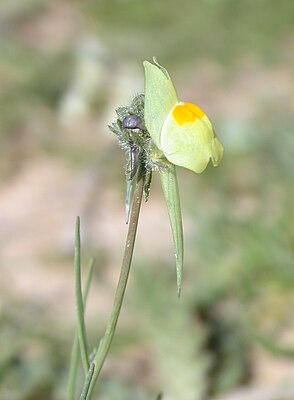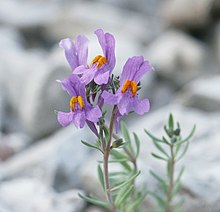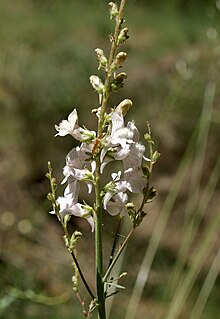Toadflax
| Toadflax | ||||||||||||
|---|---|---|---|---|---|---|---|---|---|---|---|---|

|
||||||||||||
| Systematics | ||||||||||||
|
||||||||||||
| Scientific name | ||||||||||||
| Linaria | ||||||||||||
| Mill. |
The linaria ( Linaria ) are a plant genus that the family of plantain plants belongs (Plantaginaceae). The genus name is derived from the similarity of the leaves of the yellow blooming toadflax ( Linaria vulgaris ) with those of the flax (Linum). The genus Linaria includes 100 to 150 species , most of which are native to the temperate areas of Eurasia , especially the Mediterranean .
description



Vegetative characteristics
The toadflax species are one , rarely two years to often perennial , herbaceous plants and grow upright, prostrate, creeping or hanging. The leafy stems and leaves are bare. The foliage leaves, which are arranged at the base in several together and opposite or alternating, spirally or four-line distributed on the stem are sessile or have a more or less long petiole. The herbaceous, membranous or leathery leaf blade is linear to oblong or rounded. The leaf margin is smooth. Stipules are missing.
Generative characteristics
The flowers are in terminal racemose , spiked or rarely capped inflorescences that have bracts , but no bracts . Rarely do the flowers stand individually in the axils of foliage leaves. There may be flower stalks.
The hermaphrodite flowers are clearly zygomorphic , five-fold and have a double flower envelope (perianth). The five sepals are usually only fused at their base, often unequal. The colors of the five tubular, fused petals range from white or yellow to orange or pink to purple and violet to blue. The crown is two-lipped, the upper lip is two-lobed, the lower lip is three-lobed. The lower lip is arched and closes the throat (mask flower). The crown forms a clear spur at the bottom. The two unequal pairs of stamens are not among each other, but fused with the corolla tube, which they do not protrude. Two carpels have become a top permanent ovary grown.
The egg-shaped or spherical capsule fruits open with serrated holes. The uneven fruit compartments contain many seeds. the seeds are flat, often disc-shaped with a broad-winged edge or rarely triangular and wingless or kidney-shaped with a thickened edge. Seeds have an oily endosperm . The embryo is straight to curved.
ecology
The pollination is effected by insects ( Entomophilie ).
Systematics and distribution
The genus Linaria was established in 1754 by Philip Miller in The Gardeners Dictionary ... Abridged ... , 4th edition, 2nd volume. Type species is Linaria vulgaris Mill. Synonyms for Linaria Mill. Are: Trimerocalyx (Murb.) Murb. , Nuttallanthus D.A.Sutton . The genus Linaria belongs to the Antirrhineae tribe in the Plantaginaceae family.
The genus flax herbs ( Linaria ) contains around 100 to 150 species (selection):
- Linaria aeruginea (Gouan) Cav. : It occurs in Portugal , Spain and the Balearic Islands .
- Linaria algarviana Chav. : It occurs in Portugal.
- Alpine toadflax ( Linaria alpina (L.) Mill. )
- Linaria amethystea (Lam.) Hoffmanns. & Link : The home is Portugal, Spain and Morocco .
- Linaria amoi Campo ex Amo : It occurs in Spain.
- Narrow-leaf toadflax , Italian toadflax ( Linaria angustissima (Loisel.) Borbás )
- Linaria anticaria Boiss. & Reuter : It occurs in Spain.
- Field toadflax ( Linaria arvensis (L.) Desf. )
- Linaria badalii Willk. : The home is Spain.
- Linaria bessarabica Kotov : Ukraine is our home.
- Linaria biebersteinii Besser : It occurs in Russia , Moldova , Romania , Slovakia and the Ukraine ( Crimea ).
- Linaria bipartita (Vent.) Willd. : The homeland is Morocco.
- Linaria bipunctata (L.) Dum.-Cours. : The home is Portugal and Spain.
- Linaria bungei Kuprianova : It is common in Kazakhstan , Kyrgyzstan , Russia and in the Chinese Xinjiang .
- Linaria buriatica Turcz. ex Benth. : The homeland is China and Siberia and Mongolia.
- Linaria caesia (pers.) DC. ex Chav. : The home is Portugal and Spain.
- Linaria canadensis (L.) Dum.-Cours. : It is common in the New World.
- Linaria capraria Moris & De Not. : She is endemic to Italy .
- Linaria cavanillesii Chav. : She is endemic to Spain.
- Linaria chalepensis (L.) Mill .: It occurs in southern Europe , North Africa and the Middle East .
- Linaria concolor Griseb. : It occurs in Serbia , Greece and Ukraine.
- Linaria coutinhoi Valdés : It occurs in Portugal.
- Linaria cretacea Fischer ex Spreng. : It occurs in Russia and Ukraine.
- Dalmatian toadflax ( Linaria dalmatica (L.) Mill. ): The home is south-east Europe and west Asia . It is also known as the subspecies Linaria genistifolia subsp. dalmatica (L.) Maire & Petitm. to Linaria genistifolia (L.) Mill .
- Linaria debilis Kuprian. : It occurs in Russia.
- Linaria elegans Cav. : The home is Portugal and Spain.
- Gorse toadflax ( Linaria genistifolia (L.) Mill. ): It is in Central Europe, Southeast Europe, Eastern Europe , West Asia to Central Asia and Siberia spreads.
- Linaria haelava Delile : The home is Cyprus , Libya , Egypt , the Sinai Peninsula and Palestine .
- Linaria incarnata (Vent.) Spreng. : The homeland is Spain, Portugal and Morocco.
- Linaria japonica Miq. : The home is East Asia, China, Japan and Korea .
- Linaria kulabensis B. Fedtschenko : It occurs in Tajikistan and in the Chinese Xinjiang.
- Linaria lamarckii Rouy : The home is Portugal and Spain.
- Linaria longicalcarata D.Y. Hong : The home is the Chinese Xinjiang.
- Linaria maroccana Hook. f. : The homeland is the Atlas Mountains of Morocco.
- Linaria micrantha (Cav.) Hoffmanns. & Link : The home is southern Europe, North Africa and the Middle East.
- Linaria nivea Boiss. & Reut. : The home is Spain.
- Linaria pedunculata (L.) Chaz. : The homeland is Spain, Portugal, Algeria , Morocco and Tunisia .
- Linaria pelisseriana (L.) Mill .: The home is southern Europe, North Africa and the Middle East.
- Linaria pinifolia (Poir.) Thell. : The homeland is Algeria and Tunisia.
- Linaria pseudolaxiflora Lojac. : She is endemic to Sicily .
- Purple toadflax ( Linaria purpurea (L.) Mill. ): The home is Italy.
- Linaria reflexa (L.) Desf. : The homeland is Italy, Sicily and Sardinia , Albania and Greece, Algeria, Morocco and Tunisia.
- Striped toadflax ( Linaria repens (L.) Mill. )
- Linaria saturejoides Boiss. : It occurs in Portugal and Spain.
- Linaria saxatilis (L.) Chaz. : The home is Portugal and Spain.
- Linaria simplex (Willd.) DC. : It occurs in southern Europe, North Africa and the Middle East.
- Tailed toadflax ( Linaria spartea (L.) Chaz. ): The home is Portugal, Spain and France .
- Linaria supina (L.) Chaz. : The home is Portugal, Spain, France, Italy and Switzerland .
- Linaria thibetica Franchet : It thrives at altitudes of 2500 to 3800 meters in Tibet and in the Chinese provinces of Sichuan and Yunnan .
- Linaria thymifolia (Vahl) DC. : It occurs in France.
- Linaria tonzigii Lona : She is endemic to Italy.
- Linaria triornithophora (L.) Cav. : The home is Portugal and Spain.
- Linaria triphylla (L.) Mill .: It occurs in southern Europe, North Africa and the Middle East.
- Linaria tristis (L.) Mill .: It occurs in Portugal, Spain, Algeria and Morocco.
- Linaria uralensis Kotov : Home is the Urals .
- Linaria viscosa (L.) Dum.-Courset : The home is Portugal, Spain, Italy, Sicily, Morocco and Algeria.
- Toadflax , female flax ( Linaria vulgaris Mill. ): It is common in Eurasia .
The following are no longer included in this category:
- Linaria cymbalaria (L.) Mill. → Cymbalaria muralis P.Gaertn., B.Mey. & Scherb.
- Linaria minor (L.) Desf. → Chaenorrhinum minus (L.) Lange
- Linaria spuria (L.) Mill. → Kickxia spuria (L.) Dumort.
- Linaria elatine (L.) Mill. → Kickxia elatine (L.) Dumort.
swell
- Deyuan Hong, Hanbi Yang, Cun-li Jin, Manfred A. Fischer, Noel H. Holmgren, Robert R. Mill: Scrophulariaceae : Linaria , p. 49 ff. - online with the same text as the printed work , In: Wu Zheng-yi, Peter H. Raven (Ed.): Flora of China. Volume 18: Scrophulariaceae through Gesneriaceae. Science Press and Missouri Botanical Garden Press, Beijing and St. Louis, 1998, ISBN 0-915279-55-X . (Sections Description and Systematics)
- Entry in the Western Australian flora . (Section description)
- Arthur Oliver Chater, Benito Valdés, David Allardice Webb: Linaria Miller. In Thomas Gaskell Tutin et al .: Flora Europaea . Volume 3, pp. 226-236. Cambridge University Press 1972, ISBN 0-521-08489-X .
Individual evidence
- ↑ a b c d e f g h i j k l m n Linaria in the Germplasm Resources Information Network (GRIN), USDA , ARS , National Genetic Resources Program. National Germplasm Resources Laboratory, Beltsville, Maryland.
- ↑ a b c d e f g h i j k l m n o p q r s t u v w x y z aa ab ac ad ae af ag ah ai Karol Marhold: Scrophulariaceae. In: Euro + Med Plantbase - the information resource for Euro-Mediterranean plant diversity. Berlin 2011.
- ↑ a b c d Manfred A. Fischer, Wolfgang Adler, Karl Oswald: Excursion flora for Austria, Liechtenstein and South Tyrol . 2nd, improved and enlarged edition. State of Upper Austria, Biology Center of the Upper Austrian State Museums, Linz 2005, ISBN 3-85474-140-5 .
- ↑ a b c d Siegmund Seybold (Ed.): Schmeil-Fitschen interactive . CD-ROM, version 1.1. Quelle & Meyer, Wiebelsheim 2002, ISBN 3-494-01327-6 .
- ↑ a b c d e Deyuan Hong, Hanbi Yang, Cun-li Jin, Manfred A. Fischer, Noel H. Holmgren, Robert R. Mill: Scrophulariaceae : Linaria , p. 49 ff. - online with the same text as the printed work , In: Wu Zheng-yi, Peter H. Raven (Ed.): Flora of China. Volume 18: Scrophulariaceae through Gesneriaceae. Science Press and Missouri Botanical Garden Press, Beijing and St. Louis, 1998, ISBN 0-915279-55-X .




